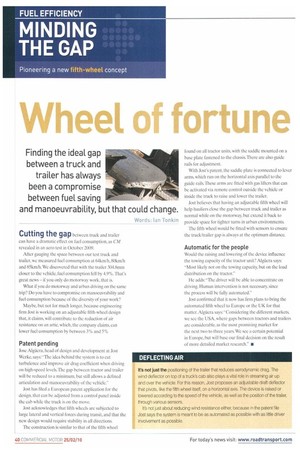Finding the ideal gap between a truck and trailer has
Page 40

If you've noticed an error in this article please click here to report it so we can fix it.
always been a compromise between fuel saving and manoeuvrability, but that could change.
Cutting the gap between truck and trailer can have a dramatic effect on fuel consumption, as CM revealed in an aero test in October 2009.
After gauging the space between our test truck and trailer, we measured fuel consumption at 64km/11,80km/1i and 85km1h. We discovered that with the trailer 304.8mm closer to the vehicle, fuel consumption fell by 4.9`)/0.That's great news — if you only do motorway work, that is What if you do motorway and urban driving on the same trip? Do you have to compromise on manoeuvrability and fuel consumption because of the diversity of your work?
Maybe, but not for much longer, because engineering firm Jost is working on an adjustable fifth-wheel design that, it claims, will contribute to the reduction of air resistance on an artic, which, the company claims, can lower fuel consumption by between 3% and 5%
Patent pending Jose AlgUera, head of design and development at Jost Werke, says: "The idea behind the system is to cut turbulence and improve air drag coefficient when driving on high-speed levels, The gap between tractor and trailer will be reduced to a minimum, but still allows a defined articulation and manoeuvrability of the vehicle.
Jost has filed a European patent application for the design, that can he adjusted from a control panel inside the cab while the truck is on the move, Jost acknowledges that fifth wheels are subjected to large lateral and vertical forces during transit, and that the new design would require stability in all directions.
The construction is similar to that of the fifth wheel found on all tractor units, with the saddle mounted on a base plate fastened to the chassis. There are also guide rails for adjustment.
With Jost's patent, the saddle plate is connected to lever arms, which run on the horizontal axis parallel to the guide rails, These arms are fitted with gas lifters that can be activated via remote control outside the vehicle or inside the truck to raise and lower the trailer.
Jost believes that having an adjustable fifth wheel will help hauliers close the gap between truck and trailer as normal while on the motorway, but extend it back to provide space for tighter turns in urban environments.
The fifth wheel would be fitted with sensors to ensure the truck/trailer gap is always at the optimum distance.
Automatic for the people
Would the raising and lowering of the device influence the towing capacity of the tractor unit? Alguera says: "Most likely not on the towing capacity, but on the load distribution on the tractor."
He adds: "The driver will be able to concentrate on driving. Human intervention is not necessary, since the process will be fully automated."
Jost confirmed that it now has firm plans to bring the automated fifth wheel to Europe or the UK for that matter. Algiiera says: -Considering the different markets, we see the USA, where gaps between tractors and trailers are considerable, as the most promising market for the next two to three years. We see a certain potential in Europe, but will base our final decision on the result of more detailed market research." •




































































































































